 |
A-26B Invaders - Warton -
29th November 1944
"Bombers in the Marsh" |
 |
 |
A-26B Invaders - Warton -
29th November 1944
"Bombers in the Marsh" |
 |
Last Updated: 27.07.2018
|
Type |
Serial No. |
Unit |
Base | Crew | Passengers |
|
A-26B-10-DT |
43-22298 |
641st Squadron |
Bretigny, France |
2 |
- |
|
A-26B-15-DT |
43-22336 |
641st Squadron |
Bretigny, France |
1 |
- |
In July 2005 The Lancashire Aircraft Investigation Team, together with members of RAF Millom Museum took part in a major project in association with the Channel 4 Television's Time Team. The aim was to excavate the crash sites of two A-26 Invader aircraft which collided shortly after take-off over the marshes close to the then USAAF BAD 2 airbase at Warton. This project was the culmination of months of planning and preparation as the site was probably one of the most demanding that we, or the Time Team have attempted to work on.
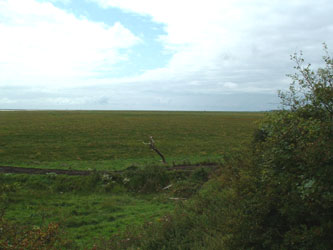 |
|
|
Warton Marsh - from solid ground! |
Tail fin protruding above the marsh |
It all started with an email stating that the Time Team producers were looking for an Aviation Archaeology project for their next series, setting out their criteria for their ideal site. Apart from the usual required “mystery” behind the incident, it seems that they had become concerned as to the depth many of “our” excavations seem to require and also, as the programme aims to bring aspects of archaeology to a general audience, they had decided that they wanted “recognisable” aircraft remains to work on! A pretty tall order for a crash site in the UK, as such sites are more associated with remote tropical jungles or inaccessible mountain peaks. However, after some discussion we decided that we were still interested in taking part in a joint project and that we did indeed have the perfect site, though with one slight complication – it was nearly one mile from solid ground on a marsh! The producer's interest was aroused and a meeting to view the site was arranged, leading to the not altogether inconspicuous arrival of the famous Time Team Land Rover Discovery at Freckleton. On the walk out to the site, accompanied by a representative of the Lytham and District Wildfowlers Association, who own and manage the marsh, we had plenty of time to describe the background to the incident and relate how we believed at least one of the two aircraft lay almost intact only a few feet below the surface! I confess this may have seemed pretty far-fetched at first, but we had done our research and the sight of the tattered vertical fin poking through the grass soon vouched for our story and the initial planning stage of the project began.
|
|
|
|
43-22298 flown by 2nd Lt. Kenneth E. Hubbard |
43-22336 flown by 2nd Lt. Norman Zuber |
From original photographs of the crash scene in 1944 we had a rough idea of where the remains of the two aircraft should lie, in relation to each other, but due to the size of the area covered we were asked to locate and plot as much of the wrecks as possible. work also began on the task of collating our research notes and tracking down any surviving witnesses or relatives of the crews. The aircraft involved were two A-26B Invaders; 43-22298 and 43-22336, both had been built only a month apart at the Douglas plant at Tulsa, Oklahoma and flown to the UK probably via Prestwick during October or November of that year. Production records indicate that the two aircraft differed slightly - a factor that would prove important to us 60 years later. They were then transferred to the American, Base Air Depot 2 (BAD2) at Warton where they joined others being prepared and waiting to be allocated to front line units of the Ninth Air Force, in replacement for A-20 and B-26 aircraft. One of these units was the 641st Squadron of the 409th Bombardment Group who since September had been based at Station A-48, Bretigny, Seine Oise, France, flying regular combat sorties, mostly against close support targets in their A-20s. From mid November they began converting to the A-26 and later that month a group of pilots from the squadron flew their old A-20s to Warton in order to familiarise themselves with their new charges and fly them directly back to their base. Just after 12.00 hours on the 29th November 1944 the A-26s began taking off from BAD2 and forming up over the airfield ready for the return flight to France. Witnesses recall some 20 aircraft being in the air above the base, where the Invaders were forming up in four flights of six aircraft - 43-22298 was being flown by 2nd Lt. Kenneth E. Hubbard accompanied by Pvt. John F. Guy, a crew chief, was forming up as No. 6 in the first flight, when his aircraft collided with 43-22336 flown by 2nd Lt. Norman Zuber who was unaccompanied. Witnesses recall that one aircraft exploded on contact and a fellow pilot from Hubbard’s flight recalls he saw a ball of flame with a propeller protruding from it as it fell. He was so shocked that he continued the flight out of formation, keeping a secure distance from the other aircraft. The second aircraft was seen to fall out of control with one wing missing outboard of the engine – It all happened so fast that the witness statements at the time seem confused as to what had actually occurred.
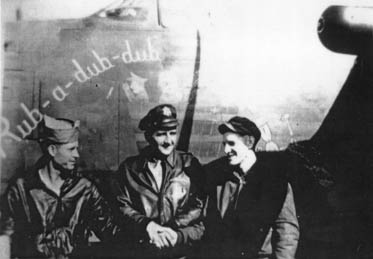 |
 |
|
2nd Lt. Kenneth E. Hubbard (centre) |
2nd Lt. Norman Zuber (centre) |
Both
planes fell on tidal mudflats in the Ribble estuary close to the base and at
first there seemed hope that there could be survivors and as crowds gathered at
the waters edge, some thought they saw movement inside one of the fuselages.
Many servicemen from BAD2 had witnessed the tragedy and one of them; Sgt
Stanley C. Begonsky immediately began to wade and then swim out to the burning
aircraft, being the first to reach them. At the first aircraft the fire had by
now died down, but as he looked into the cockpit he realised that the two
crewmen inside were beyond help. He then waded to the second still burning
plane, but at first he could see little through the thick smoke. Crouching down
he chopped his way into the cockpit where he found the pilot amidst flames and
began to drag him out, but sadly again he was beyond help, having been killed
instantly in the impact. By this time several lifeboatmen arrived at the scene
in the local lifeboat boarding boat – the lifeboat itself being out of action
whilst undergoing repairs. They recovered the two bodies from the first aircraft
with the help of Sgt Begonsky, who showed them how to gain access to the cockpit
and then returned amid exploding flares and burning fuel to recover the third
body and transported them all back to the shore. Sgt Begonsky and the 10
lifeboatmen involved received awards for gallantry for their rescue attempts.
For some reason the wrecks were left where they had fallen, gradually
disappearing from view as the marsh began to consolidate and the level of mud
rose to cover them. Only the tail of 43-22298 remained visible by the 1950s,
providing occasional shelter during inclement weather for the few hardy
wildfowlers who ventured out on to this part of the marsh.
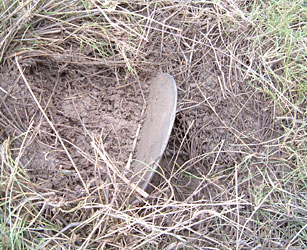
|
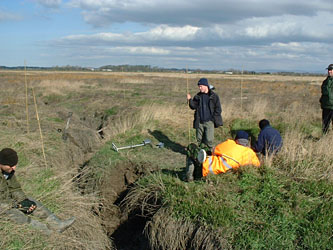
|
|
Propeller blade tip hidden in the grass. |
Our Forster Magnetometer hits pegged out |
By the time of our next visit at the end of February we had spent many hours poring over photographs from the crash report and aerial surveys at the local Record Office, attempting to workout exactly where the various sections would lie – now we would see if theory would translate into practice! Two of our team recalled an expedition to the site in the 1980s when two propeller blade tips had also been visible, but these too had apparently vanished. However the preparation paid off and by the time we packed up, we had located both aircraft and their four engines – the two prop tips were still there, hidden in the grass - as we discovered when tripping over one of them! Planning now began in earnest with permit applications being submitted to the MOD and consultation with regards to the equipment and logistics that would be required to carry out an excavation in such difficult terrain. Things were not to run smoothly, as preparations progressed it became clear that the essential MOD permits were not forthcoming and after numerous enquiries it finally transpired that a permit could now not be issued with out English Nature consent, the site being SSSI designated and we had been awaiting MOD consent before approaching English Nature!
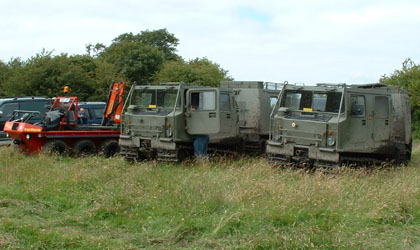
|
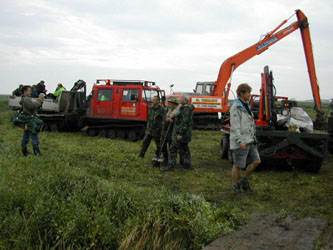
|
SupaCat and Hagglund BV206 all-terrain vehicles |
More toys to play with! |
As with all such projects the date set seemed to arrive all too quickly and before long we were again at the site, this time as preparations for the dig started two days before filming – tracks across the marsh had to be marked out, tidal gutters bridged and plant equipment moved out to the site. The “incident room” was set up at the BAe Warton Sports Club and the on-site catering arrived – certainly a bit different from our usual dig arrangements! Access to the site was to be via two Hagglund BV206 all-terrain personnel carriers. Other specialist equipment included; a third trailer equipped Hagglund , a six wheeled all-terrain crane-equipped Supacat, two high flotation tracked 20 ton excavators, one with long reach arm and a 12 ton tracked dumper – plenty of toys to play with! Various “experts” were brought in by TT including Guy De La Bedoyere and Air Crash Investigator Steve Moss, as well as an RAF “crash and smash” team and EOD.
|
|
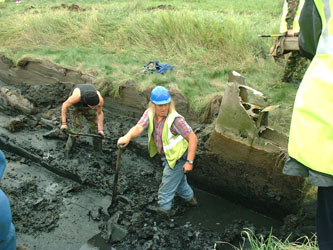 |
| John Gater and the "pram" shortly before its demise! | Phil realising that the fin really is still attached to something! |
“Day 1” of filming saw the first two “trenches” opened on the tail section of 43-22298 and one of the buried detached engines that we had identified. Geophys were busy surveying the areas that we had indicated – no doubt glad that we had narrowed down the area for them from the 20 or so acres we had started off with, for our grid search months earlier - especially as their fancy (and no doubt very expensive) wheeled "pram-like" contraption was unable to cope with the conditions and broke! Progress on the engine was rapid with the excavator carefully avoiding the upright propeller blade that had protruded only a couple of inches above the surface. Once the engine was reached the excavation continued by hand and with a nearby gutter dammed, the excavation stayed surprisingly dry. Unfortunately the same could not be said over at the tail where almost constant ingress of water made conditions very sticky indeed, but Phil Harding was on the case and determined not to be beaten. The engine proved remarkably undamaged and cylinder heads, exhaust stacks and ignition harness were soon revealed as well the still attached propeller with all three blades intact. Though moving back towards the ancillary section revealed a different story – the magnesium supercharger and accessory casings had completely disappeared leaving ancillary assemblies lying loose, including a superbly preserved carburetor. The same was found to be the case with the reduction gear casing, where of course the engine makers plate would have been, meaning identification of which plane this engine had originated from would be difficult – Fortunately one of the modifications known to have been incorporated on one of the aircraft was the fitting of R-2800-71 engines, with an improved ignition system using the distinctive General Electric “Turtleback” combined distributor magneto units and has the mud was cleared one of these units was uncovered still in place and clearly bearing its “GEC” logo cast into the casing. This engine was therefore from 43-22336 flown by 2nd Lt. Norman Zuber and perhaps this was the propeller seen “protruding from a ball of flame” 60 years before? As the day drew to close and the film-crew seemed happy with their coverage of the excavation of the engine it was decided that it could now be lifted whilst there was sufficient light to film the operation.
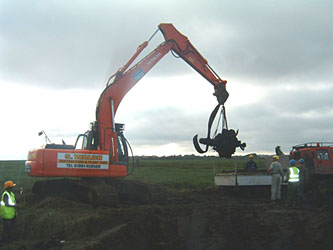 |
|
| The detached R-2800 is uncovered... | ....and lifted at the end of "Day 1" |
"Day 2" started with a final check of the engine trench for any missed loose artifacts, followed by the opening of what was to be one of the biggest ever trenches on Time Team, on the remains of 43-22298. Geophys had already produced a remarkably aeroplane shaped printout after passing their instruments over the site - complete with wings – much to the amusement of an incredulous Tony Robinson. However it came as no surprise to us having spent so much time studying the crash photos and aerial surveys, we were already convinced of what lay below, but what condition it would be in after 60 years no one could predict.
|
|
|
|
Opening the Trench on Hubbard's A-26 - 43-22298 |
Carefully scooping mud away as the airframe emerges |
|
|
|
|
Tony tries to make sense of the uncovered remains |
|
As the cockpit area began to
emerge, the first signs appeared promising, with solid skinning to the fuselage
sides and wing roots, but then we realised that we were in fact looking at the
additional thick duralumin cladding applied as extra protection against small
arms fire when attacking ground targets at low level. In fact as the wings and
remains of the rear fuselage began to emerge we realised that we were looking at
a 20th Century “fossil” with much of the metal being replaced by
crystalline corrosion products and concreted mud. Still it looked amazing as the
distinctive outline of a Douglas Invader began to emerge. Conditions were sticky
to say the least as we cleared the final layer of mud from around the fuselage
by hand to avoid damage and trying to excavate inside the restricted space in
the fuselage
was really slow going. Another problem was sinking into the glutinous morass and
I noted that TT Supervisor Kerry Ely had found a nice solid object to stand on
and save him from losing his wellies, until I politely pointed out to him that
his handy foothold was in fact a .50 calibre Browning machine gun! This was the
EOD team’s cue to emerge from their tent and with the film crew in position,
the gun was removed to their custody to be X-rayed to ensure no live ammunition
was present.
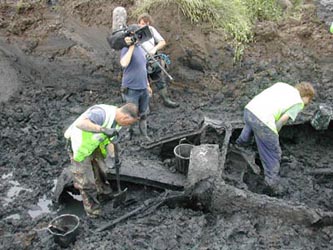 |
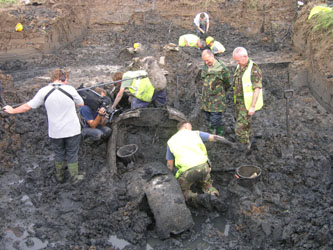 |
| Kerry uncovers his "foothold in the nose of the A-26 | EOD move in as preparations are made to lift the gun |
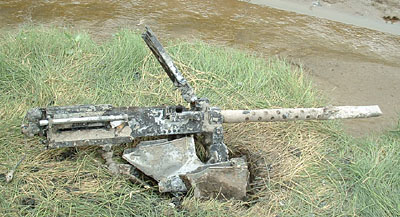 |
|
| A superb find
- the recovered .50 Browning - though declared clear of ammunition, it was taken into custody of EOD and later blown to pieces |
|
As the day progressed we reached the relatively hard sand which formed the original surface the aircraft had landed on 60 years before and another surprise awaited us. The uncovered fuselage proved to be only some three to four feet high – it had obviously impacted flat with almost no forward momentum, the sides of the fuselage ballooning out as if it had been squashed flat. In fact the gunners control position in the rear fuselage had completely collapsed, no longer having the structure of the severed tail unit to support it. The sides had burst outwards and the glazed escape hatch, once set in the top of the fuselage, was found lying on the sand, pinned down by a large and heavy cylindrical object that had fallen from the upper section of the rear bomb bay.
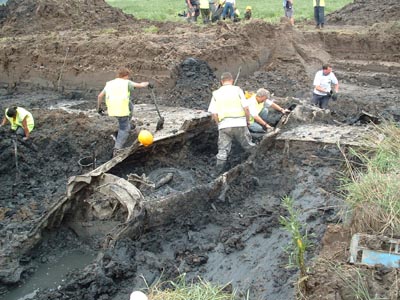 |
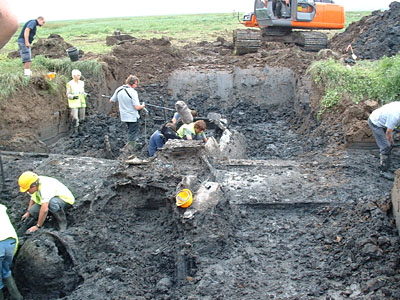 |
| The outline of the A-26 becomes apparent. | The shattered rear fuselage emerging from the mud |
Uncovering the
perforated cooling sleeves of the twin .50 Brownings protruding from the domed
cover quickly identified this as the remotely operated upper gun turret, part of
one of the most sophisticated airborne fire control systems of WW2. Back at the
tail section, the trench was by now taking on the appearance of a small lagoon,
with the now fully exposed rear fuselage still clearly marked with its “Star
& Bar” insignia. However hopes of lifting this section in one piece were
diminishing rapidly, with a serious crack from the impact now opening up,
coupled with a large section of the underside having been torn out as the lower
turret obviously fell away when the plane broke up in the air - the turret
itself being found in a tidal gutter between the two sites.
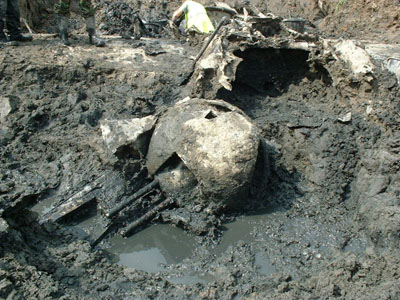 |
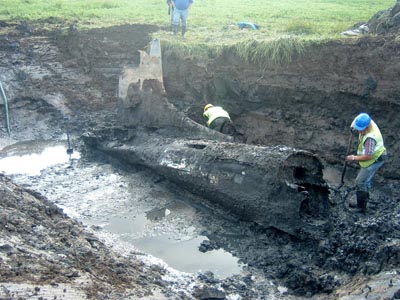 |
|
Intact remotely
controlled twin .50 turret - though recovered |
The fully exposed tail
section sits on the relatively solid sand of the 1944 beach level (note star & bar insignia just visible) |
"Day 3" promised to be pretty hectic, as usual for Time Team - though we had discussed the possibility of excavating a complete aircraft, the reality was something else! The tail section had yet to be lifted, pending the decision on cutting it into two parts – recovery of this section had originally been scheduled for Day 1! We continued to clear the fuselage of 43-22298, revealing the full length of the starboard wing and the shattered spars protruding from the torn off port wing. The rear fuselage, though now flattened was found to extend to the point where the separated tail section began, but beyond it a further section of airframe began to come to light. This proved to be the starboard nacelle, which had been swept from the wing by the force of the impact and the rear end fairing showed clear evidence of an internal explosion at the site of the de-icing fluid reservoir. Priority was given to clearing the cockpit and centre fuselage, the latter proving almost impossible due to the burnt and shredded remains of the centre self-sealing fuel tank.
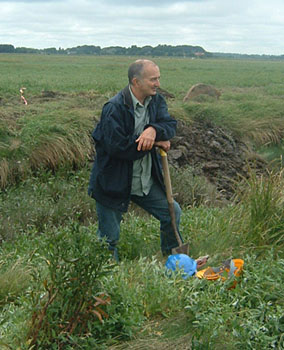 |
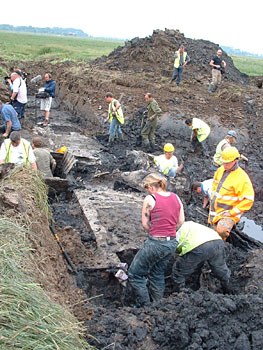 |
| Tony surveys the scene whilst awaiting his cue. | The full wingspan of the A-26 revealed. |
The cockpit also showed
signs of a brief but intense fire, with plenty of charred wiring, but no signs
of any instrumentation or flying controls. Also obviously absent was the
complicated hydraulic systems behind the pilots position - it became clear that
although the wreck had not been recovered, there had been a thorough and
systematic stripping out of most of the avionics – hardly surprising as the
A-26 was probably the technical equivalent in its day of the Eurofighter, which
constantly over-flew the site throughout the 3-day project, often so low it was
obvious that they were trying to get a better look at the dig! Digging further
into the cockpit revealed dramatic evidence of the impact, as the folded nose
wheel assembly, complete with intact wheel and tyre, had been forced up through
the cockpit floor. With the lift of the tail finally completed, albeit in two
sections, more diggers were freed to finish clearing the incredibly intact
airframe. The upper turret was lifted in one piece, though largely held together
with mud and the starboard engine was cleared ready to lift, proving that it had
broken away from its mountings and in fact lay several feet in front of its
original position.
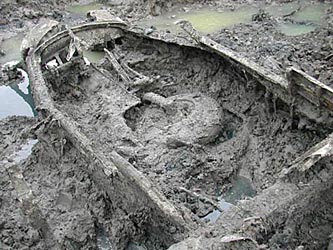 |
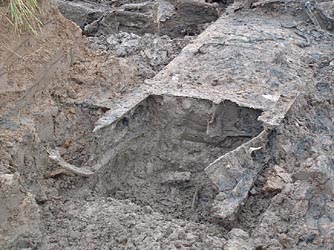 |
| Nose wheel forced up through the cockpit floor. | Clear evidence of collision damage. |
As the filming drew to a close the “experts” began piecing together the evidence to come up with their theory on how the two A-26s came to collide. In the past people had noted the position of the then visible wreckage, in relation to the alignment of the main runway at Warton and had assumed that this was a simple take-off accident. The front aircraft either slowing down or the rear aircraft applying too much power and running into the back of the former. Our research had already showed that the aircraft were in fact circling the airfield whilst they got into their assigned positions to fly in formation.
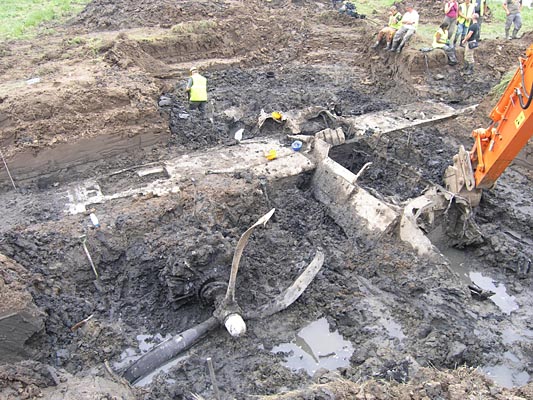 |
|
A 20th Century “fossil” - Hubbard's A-26 revealed. |
The A-26 was
a brand new aircraft and had only just gone into operational use, but a
major
problem had already emerged – that of pilot visibility beyond the
prominent
engine nacelles. A revised canopy arrangement had quickly been drawn up
to at
least partly alleviate the problem, but revising the production line
and
modifying aircraft already delivered was giving Douglas further
headaches. In
fact they did attempt to introduce the new design by hand building the
modified
section in lieu of a major revision of the line, but this obviously
slowed
production and no provision for field modification was put in place.
Hubbard’s
aircraft appeared from the records to have been fitted with the
original style
of canopy and this was confirmed during the excavation. Zuber’s on the
other
hand should have had the revised canopy, perhaps this why Hubbard was
accompanied by a flight engineer and Zuber not? In the event it made no
difference. A large gouge in the top of the tail section appeared to
indicate
that first contact had been made in this area (in contradiction to TTs
findings!). If the propeller had then sliced into the top of the
gunners compartment and damaged this weaker, glazed section of the
airframe,
it would fit that this, together with the
weight of the ventral turret behind this position must have led to the
break-up.
Though we could find no distinctive propeller slashes in any of the
surviving
airframe sections,
collision damage was clearly visible on the propeller blades attached
to the engines from both
aircraft (another fact overlooked) and the evidence seemed to point to
the two aircraft having almost become
locked together – especially as the two wrecks came down within 80 feet
of each other
- Hubbard's aircraft in particular with very little apparent forward
momentum.
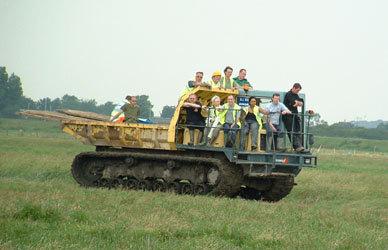 |
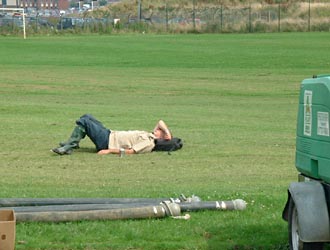 |
| Slow maybe, but much a more comfortable ride than a Hagglund! | Tony takes a break during filming! |
In the final analysis there seems little point in trying to attribute blame for this incident, it serves no purpose in our opinion, there is no doubt that both pilots were very accomplished and experienced, each having completed some 50 missions, but both were inexperienced on the type. The visibility problems had already been identified, particularly with regard to close formation flying and this was undoubtedly a critical factor, but actually establishing which plane hit which is impossible to ascertain and perhaps it is better to leave it that way. In our view, the most important outcome of this project, was the opportunity to uncover and properly record one of the most intact aircraft wrecks in the UK, whilst there is still enough left to examine. The advanced state of corrosion surprised everyone – not even the virtually anaerobic conditions present in the marsh could prevent the aircraft alloys disintegrating, providing a graphic warning that wreckage at all such crash sites will eventually succumb. The recovered engines and tail section hopefully can be successfully conserved and will form a dramatic memorial at the RAF Millom Museum.
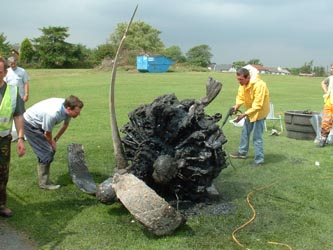 |
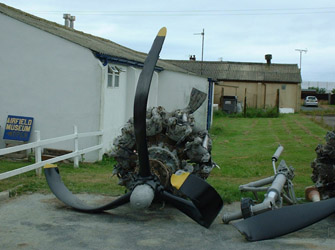 |
|
R-2800-71 Engine from Zuber's A-26, immediately following its recovery. |
Cleaned engine from
Zuber's A-26 and mainwheel
leg temporarily displayed outside the RAF Millom Museum |
The following day, with filming finished, we were given permission to use the equipment, when it was not required landscaping the filled-in TT excavations, to continue our recovery work. We discussed the options and decided to excavate the second aircraft, as we knew from study of the crash report photos that this had been already largely destroyed in the impact and subsequent fire. We reasoned that any attempt to disturb Hubbard’s aircraft would have simply resulted in its disintegration, leaving us with little more than a lorry-load of individual components. As we were dealing with identical aircraft it seemed disrespectful to commit such vandalism when the second aircraft was probably little more than individual components anyway.
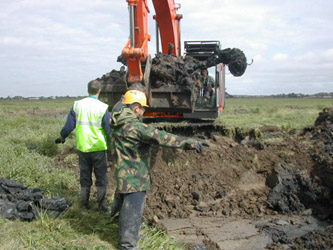 |
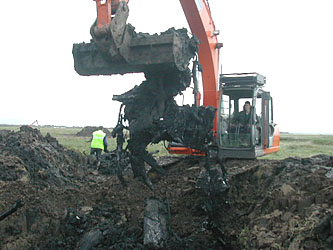 |
| First major find - a mainwheel oleo leg | Nosewheel leg and associated structure. |
Progress was rapid and as the mud was scooped clear, our theory proved correct with the wings having been reduced to little more than a pair of girder-like spars, though an intact main oleo unit was recovered complete with charred tyre. The upper gun turret was next, minus it guns, but this was almost entirely reduced to corrosion products and rapidly disintegrated when moved. It did reveal the bomb racks below and these were duly recovered. Moving aft we found no substantial remains of the tail section, despite this being visible in the photographs, so we then followed the trail of wiring forward. This soon brought several duralumin cladding sections from the cockpit to light, but this time there was no aircraft structure behind them. The only substantial remains of the airframe found was the cockpit floor section, which had embedded in the sand and escaped the fire. This still had the complete nose wheel assembly folded into its well underneath – the wheel had disappeared but the tyre was unmarked.
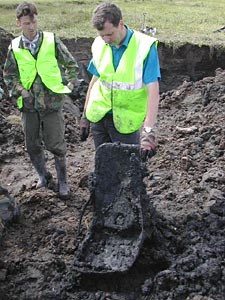 |
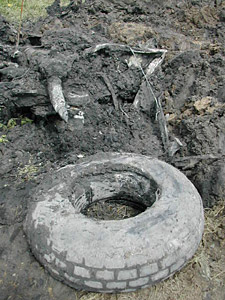 |
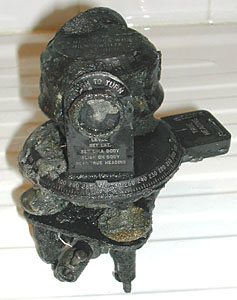 |
| Pilots seat -last occupied by 2nd Lt. Zuber | Nosewheel tyre with inflated inner tube! | Astro compass from Zuber's A-26 |
Other smaller finds included: Batteries, radios, rudder pedals, control column, intact pilot’s seat and a “unique find” - the pilot’s ashtray! Next to this was an aide-memoir card for the fuel valve settings – it seemed strange to think of the pilot surrounded by hundreds of gallons of high-octane fuel being allowed to smoke, but perhaps considering the danger these guys faced on a daily basis, the need for such “comforts” outweighed the risk? Our records of this second excavation included a sketch of where the various components had been found in relation to each other and study of this showed that Zuber’s aircraft had in fact come to rest, broken in half with the tail at 90 degrees to the forward fuselage – again indicating a weak point around the gunners position, as well as facing Hubbard’s aircraft, nose to nose! This together with the scatter of the remaining engines gives a distinct impression of the two planes spiralling down out-of control following the collision – sadly too low for any chance of bailing out.
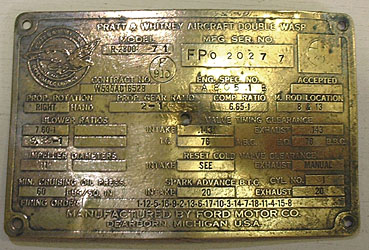 |
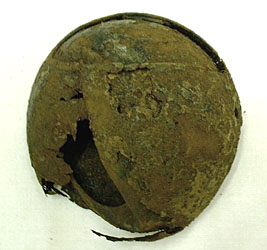 |
| Engine maker's plate from 43-22336 | Pilot's ashtray from 43-22336 |
As with many projects, two of the most interesting smaller finds only emerged during the careful cleaning and sorting of the recovered material - firstly a ball of concreted mud found pressed into the sand under the nosewheel of Zuber's aircraft proved to contain a remarkably intact Astro compass, shown here partly cleaned - the glass spirit levels built into its frame being intact and functional! The final surprise came as the engines were unloaded at the RAF Millom Museum - as the lorry driver swept the load bed before setting off on his return trip he spotted a small square piece of brass which he brought to our attention - an engine maker's plate (above). Fortunately from where it was picked up we could ascertain which engine it belonged to, but how it had remained stuck to the engine through its recovery, several power washing sessions and the 80 mile journey seems incredible. The magnesium alloy reduction gear case it had originally been attached to had long since disintegrated - as we had expected and a thorough search of the hole the engine was excavated from, had been made to see if it had fallen off, with little hope of success. We can only conclude that it had fallen into the reduction gearing and jolted loose on the journey - fortunately not falling from the lorries load bed!
Watch "Bombers in the Marsh" now on Youtube
Lytham and District Wildfowlers Association, Stanley C. Begonsky, Janice White, Ruth Yates, Mark Gaskell, Russell Brown, Andrew Boardman, Members of RAF Millom Museum and everyone else involved who made this project possible.
This page Copyright © Nick Wotherspoon 2018